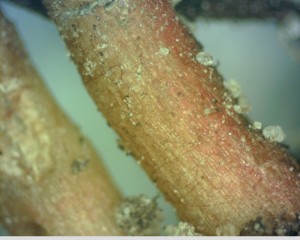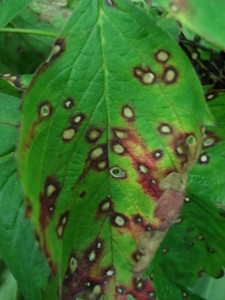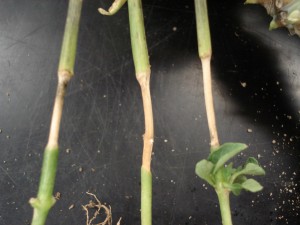Rhizoctonia root rot has been reported over the past week. Rhizoctonia root rot, caused by Rhizoctonia solani, is an important soil-borne fungal pathogen with a very large host range. The pathogen can survive saprophytically on living or dead plant material (organic matter) or as sclerotia in the soil (for more than 3 years). Disease development is favored by warm temperatures, dry (or very well drained) soils and stressed plants. Symptoms of Rhizoctonia root rot may begin as stunted plant growth (with poor root systems) with the appearance of brown lesions at the base of the stem causing wilting with lesions eventually girdling the stem and killing the infected plant. Rhizoctonia root rot infections only extend about an inch above the soil surface (Figure 1), unlike Phytophthora blight infection which can extend much farther up the stem. [Read more…]
Understanding and controlling Rhizoctonia root rot
Even though much of New Jersey has had wet weather recently, which is more favorable to Pythium and Phytophthora development, Rhizoctonia root rot has been reported over the past few weeks in a number of crops. Rhizoctonia root rot, caused by Rhizoctonia solani, is an important soil-borne fungal pathogen with a very large host range. The pathogen can survive saprophytically on living or dead plant material (organic matter) or as sclerotia in the soil (for more than 3 years). Disease development is favored by warm temperatures, dry (or very well drained) soils and stressed plants. Symptoms of Rhizoctonia root rot may begin as stunted plant growth (with poor root systems) with the appearance of brown lesions at the base of the stem causing wilting with lesions eventually girdling the stem and killing the infected plant. Rhizoctonia root rot infections only extend about an inch above the soil surface (Figure 1), unlike Phytophthora blight infection which can extend much farther up the stem. [Read more…]
Understanding and controlling Rhizoctonia root rot
Even though much of New Jersey has had wet weather recently, which is more favorable to Pythium and Phytophthora development, Rhizoctonia root rot has been reported over the past few weeks in a number of crops. Rhizoctonia root rot, caused by Rhizoctonia solani, is an important soil-borne fungal pathogen with a very large host range. The pathogen can survive saprophytically on living or dead plant material (organic matter) or as sclerotia in the soil (for more than 3 years). Disease development is favored by warm temperatures, dry (or very well drained) soils and stressed plants. Symptoms of Rhizoctonia root rot may begin as stunted plant growth (with poor root systems) with the appearance of brown lesions at the base of the stem causing wilting with lesions eventually girdling the stem and killing the infected plant. Rhizoctonia root rot infections only extend about an inch above the soil surface (Figure 1), unlike Phytophthora blight infection which can extend much farther up the stem. [Read more…]
Early-season Phytophthora blight and Rhizoctonia root rot control.
Phytophthora blight typically develops in low-lying areas after a heavy rain. Fortunately, this spring in New Jersey has been really dry – too dry thus far, but that does not need you don’t need to prepare for potential phytophthora issues down the road. This is particularly important if are in fields with a known history of Phytophthora blight. Although extended periods of dry weather works against Phytophthora development, it can lead to Rhizoctonia root rot issues in newly transplanted plugs, especially if those plugs remain on the dry side too long before watering. Symptoms of Rhizoctonia root rot appear as brown lesions at the base of the stem with those lesions eventually girdling the stem and extending about an inch above the soil surface. If transplants haven’t been treated the the cell flat prior to transplanting, apply a fungicide through the drip system soon after transplanting. [Read more…]
Vegetable Diseases of the Week – 4/26/13
 Note brown hyphae growing on surface of infected root |
Rhizoctonia root rot on infected strawberry. |
 Note circular spots with dark red margins |
Leaf spot on strawberry. |
 Note: Secondary pathogens such as Alternaria can infest bleached out areas of stems over time |
Sunscald injury on stems of newly transplanted pepper seedlings caused by stems laying against edges of black plastic mulch on hot, sunny days. |
